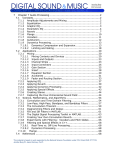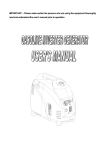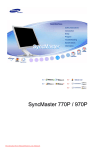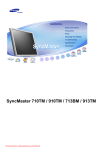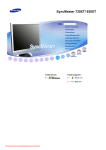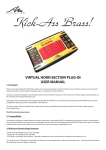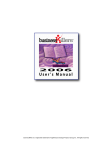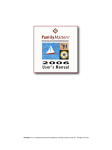Download Diagnostics Center Quality Standards 2014
Transcript
Diagnostics Center Quality Standards 2014 Diagnostics Center Quality standard ranking scale: Exemplary 100% Exceeds 99%-97% Meets 96%-90% Needs Improvement 89% and below This quality program sets performance standards for the delivery of quality service to Luxottica stores and defines the culture of service in Diagnostics Center Team. This quality program aligns with 2 agent annual performance objectives (Job Knowledge and Customer Service), acts as the method of measure for these annual performance objectives, and is used to coach and develop agents to achieve standards of excellence. Each quality element defined below is scored according to its definition and is associated with one of the two performance objectives. There are a maximum of 50 points for Job Knowledge and a maximum of 50 points for Customer Service. Examples are provided to help agents achieve standards. 6/10/2014 1 Diagnostics Center Quality Standards 2014 JOB KNOWLEDGE Issue Identification (Yes = 4 pts / No = 0 pts) The agent correctly identifies issue and seeks clarity through questioning. Agent asks all questions to understand all details of issue. Agent does not make assumptions. Agent creates a separate incident for each issue that would have a separate operational or product categorization. Verify the nature or reason for the call matches the “whisper” Example: "If I understand correctly Mary, your Spartan Edger is down, and you are unable to manufacture eyewear?…" “So (Name) you need to (insert the request as you understand), is that right?” “So are you trying to identify the part number needed?” Information Collection (Yes = 2 pts / No = 0 pts) The agent collects all issue information to troubleshoot, resolve the incident, and/or all information required for escalation. Agent avoids asking for unnecessary or unrelated information. The agent takes ownership and asks troubleshooting questions to identify the details of the issue and uncovers all needs and issues through questioning. Agent identifies customer’s level of equipment knowledge, experience and electrical certification. “What were you doing when this happened?” “Does this happen often or has this happened before?” “What’s the specific error message?” “Have you called about this issue before?” So Mary, what is your comfort level with this equipment? Are you electrically certified? Incident Customer and Contact Tab (Yes = 1 pt / No = 0 pts) Agent completes the Customer tab and changes to the correct store # if applicable (i.e. visiting agent, Regional Mangers, Field Associate). For callers without Lux ID, agent uses Lux ID replacement and documents name, location, store# and phone # in Contact Tab. Existing Incident Identification & Update (Yes = 3 pts / No = 0 pts) Agent researches historical incidents to identify existing incidents for the caller, issue, or location. The agent does not create a new incident when a related, open incident already exists. Agent locates existing incident and updates per existing Remedy guidelines. Example: “Are you aware if anyone from your lab has called about this issue before?” or any other related issues? “Were you troubleshooting any other issues prior to this current problem? 6/10/2014 2 Diagnostics Center Quality Standards 2014 Detailed Incident Summary & Notes (Yes = 4 pts / No = 0 pts) The agent uses the appropriate summary format with a clean and concise description of the issue. Notes field includes a detailed description of the issue, troubleshooting steps performed, directions provided to the customer, and the results of those actions. Appropriate Incident Template Used (Yes = 2 pts / No = 0 pts) Agent selects the appropriate template, completes all required fields, including documentation and troubleshooting. Correct Incident Classification (Yes = 1 pt / No = 0 pts) Agent chooses the correct Classification (Operational Categorization & Product Categorization Tiers) to match the issue. Appropriate Incident Assignment (Yes = 2 pts / No = 0 pts) Agent assigns the incident to the correct assignment group with the proper urgency per Remedy guidelines. Appropriate Incident Work Info & Attachments (Yes = 3 pts / No = 0 pts) Agent completes the Work Info Summary, Notes, and attaches all necessary documentation (reference pictures, video links, diagrams, screen shots, error logs, faxes from store, etc.) to facilitate timely resolution of the issue. Correct Incident Relationship (Yes = 3 pts / No = 0 pts) Agent relates incidents to an existing incident or hot ticket and selects the correct relationship. Correct Incident Status & Status Reason (Yes = 3 pts / No = 0 pts) Agent chooses the correct Status and Status Reason of the incident. Detailed Incident Resolution (Yes = 4 pts / No = 0 pts) Agent documents a concise statement in the Resolution Field and completes the correct Resolution Categorization. Example: Use Barcode K28 to identify encoder count. Bad Example: Find your User Manual, turn to page 3-4, scan barcode K28, move the cursor to encoder reading to identify the encoder count. Have a nice day. 6/10/2014 3 Diagnostics Center Quality Standards 2014 Use of Appropriate Support Tools (Yes = 3 pts / No = 0 pts) Agent is self-reliant, using all appropriate systems and tools to troubleshoot and/or resolve the issue. Agent is timely in the use of all support tools. Agent does not use tools that are not appropriate for the call or resolution of the matter Agent makes every attempt to identify the part number vs. instructing the lab associate to contact the vendor. All troubleshooting, diagrams, reference photos, and information provided to the field associate must be professional quality, and specific to the problem at hand. Use of Knowledge & Resources (Yes = 2 pts / No = 0 pts) Agent exhausts the use of all knowledge resources prior to reaching out in Chat or escalating the incident if the solution is not readily apparent. Agent list what individual troubleshooting steps were performed before reaching out to other Agents, or other resources, such as an EC technician. Correct Information and Solution Provided (Yes = 5 pts / No = 0 pts) Agent provides correct solution to caller regarding issue. Agent answers caller questions with correct information. Agent guides caller to complete necessary steps at store level. Agent supports caller through resolution to verify resolution is reached. Agent identifies the Resolution, noting what steps were taken to completely resolve the issue. Or, if a part is identified as being the source of the issue, the part must be ordered at this time. Agent must not direct the associate to perform a troubleshooting step alone, then call back with results. Provides Next Steps and Educates (Yes = 2 pts / No = 0 pts) Agent provides caller with next steps and necessary work to be done. Agent is pro-active and educates when appropriate. Agent does not overwhelm caller with irrelevant information. Example of when “next step” education is appropriate: Replacement equipment Part Order Agent specifies what parts need to be ordered, provide estimated arrival, offers replacement instructions once the part is received. In store equipment repair: Required Maintenance. Confirms Understanding (Yes = 3 pts / No = 0 pts) Agent checks for understanding. The agent responds to customer signals that may indicate the customer is unclear or unsure, such as “I think so…”, “I guess….,” “That’s fine I guess,” etc.. The agent responds to ensure the caller understands the information. 6/10/2014 4 Diagnostics Center Quality Standards 2014 Provides Incident Number to Caller (Yes = 1 pts / No = 0 pts) Agent offers to give the caller the incident number for reference and callback for every call. Example: “Would you like me to give you the incident number in case you need to call back?” Appropriate Use of Follow-Up (Yes = 2 pts / No = 0 pts) Agent uses follow-up time appropriately to enter information related to the incident(s). Do not use this time to work on unrelated issues or emails. Use the appropriate status for each activity such as email or outbound calls. Personal email or IM is not appropriate during work hours and must be addressed during a break or after hours. 6/10/2014 5 Diagnostics Center Quality Standards 2014 CUSTOMER SERVICE Professional Greeting (Yes = 4 pts / No = 0 pts) The agent can use a greeting from the examples below or incorporate the following requirements in their personal greeting. Requirements include our department name, your name, the caller’s name, caller’s Lux ID, store number and Brand. For outbound calls only, for each person on the call, confirmation you are calling from a recorded line. Examples of Greeting: Thank you for calling Diagnostics Center. This is (First Name). Can you confirm your name and location please? Thank you for calling Diagnostics Center. This is (First Name). May I have your LUX ID #, please? (if not provided by Remedy Screen Pop) Thank you for calling Diagnostics Center. This is (First Name). May I have your name please? (Franchise) Hi, this is (First Name) calling on a recorded line from Diagnostics Center. May I speak to (name) please? If the agent is unclear of caller’s name, the agent asks again or asks caller to spell his/her name. Examples of Name Clarification: “I didn’t quite catch your name, could you repeat it for me, please?” “I’m sorry, would you mind spelling your name for me, please?” Agent asks for spelling of the caller’s name, if necessary, and should make every attempt to pronounce the caller’s name. The agent may use the first or last name of the caller (ex. Mary or Ms. Smith). If there is no response to the greeting, the agent attempts to get the attention of the caller. If the caller does not respond after more than one attempt, the agent says “I’m sorry, I cannot hear you. I am disconnecting this call.” Customer Readiness/Focus (Yes = 4 pts / No = 0 pts) Agent is prepared to take call and does not use this call's time to wrap up the previous call. Agent expresses interest in the situation and demonstrates engagement by responding to the caller's concerns/questions/requests. 6/10/2014 6 Diagnostics Center Quality Standards 2014 Offers Assistance (Yes = 3 pts / No = 0 pts) Once the agent has collected and verified the caller’s name, store number, and brand, the agent offers assistance to identify the reason for the call. Examples of Offering Assistance: “How can I help you today, Mary?” “What can I do for you today, Mary?” In the event the caller provides the reason for the call before the agent can offer assistance, the agent verifies the reason and moves on to confirming assistance. Confirms Assistance Once the caller explains his/her reason for calling, the agent confirms assistance. Confirming assistance is a phrase spoken by the agent that creates caller confidence. It shows that the agent understands the caller’s question or request, prepares the caller, and lets the caller know assistance is forthcoming. This should be done before collecting detailed. In the instance additional questions need to be asked to gain clarity regarding the situation, the agent may gather and verify relevant information first before confirming assistance. Examples of Confirming Assistance: “I can help you with that Mary.” “I would be happy to help you…” and inserts the request, as he/she understands it. “Let me connect to your system.” “Let’s bypass that error message.” “Thank you. Let’s take a look at the Cycle Count.” “I’m happy to help you with that. Let me get a little more information from you…” “That’s a great question (Name). If you have a moment, I’ll do some research to find the answer.” Exceptional situation: “We are aware of this issue and we are working towards a resolution.” If the caller asks a direct question, the agent may answer the question directly without confirming assistance. The agent may also offer to research if the answer is not evident. During the conversation, when the caller requests the agent to take a specific action, the agent then confirms assistance. Not Confirming Assistance Certain phrases or actions do not build caller confidence and do not prepare the caller to receive the assistance they asked for. Examples of Not Confirming Assistance: Asking questions related to the caller’s request is not confirming assistance. Using single word confirmations, such as “Okay,” “Sure,” “Absolutely,” “Uh-Huh,” “Certainly,” etc. is not confirming assistance. Saying “One second” or “One moment” is not confirming assistance. Asking the caller to hold is not confirming assistance. 6/10/2014 7 Diagnostics Center Quality Standards 2014 Tonality (Yes = 5 pts / No = 0 pts) The agent has a pleasant, respectful, enthusiastic, energetic, caring and courteous tone of voice throughout the call and includes a positive personality starting at the greeting and throughout the call. The agent builds a relationship with the caller. The agent adjusts his or her pace, pitch, volume, and voice inflection to meet the needs of the caller. Pace – the agent is accommodating to the caller’s rate of speech and adjusts to meet the needs of the caller. An increased pace can accommodate callers who may talk fast or may be in a hurry. A slower pace can accommodate callers who talk slower or may require more information or education. The agent does not voice frustration when the caller does not adjust his/her rate of speech to meet the needs of the agent. Pitch – the agent avoids mumbling or slurring words and clearly defines words and numbers. Volume – the agent speaks at a volume that can be easily understood by the caller. A loud volume can seem overbearing or aggressive, while a soft volume may not allow the caller to hear you. Voice Inflection - the agent modifies voice tone or pitch. The agent does not sound scripted or robotic. The agent does not talk to one’s self in place of continual interaction with the caller. The agent tells the caller what he/she is doing as appropriate. The agent is not curt or rude and does not use an inappropriate tone with caller. The agent does not use commanding or demanding statements. The agent does not display any sign of uneasiness, unwillingness, boredom, exhaustion, or lack of energy in tone of voice. The agent does not sound eager to end the call. Example of Continual Interaction: “Ok, I am pulling up a visual of the equipment we are discussing. This will help me understand our next step”. “OK, I received your email, the picture is great, and I can now see what you are trying to explain.” Example of Talking to One’s Self: (the caller hears what you’re telling yourself, inappropriate information is provided) “Come on computer start up…” “Please connect this time….” “This tool never works..” Empathy (Yes = 5 pts / No = 0 pts) The agent recognizes the caller’s inconveniences and shows empathy towards the caller’s concerns. The agent shows genuine empathy when the caller suggests he/she or end customer has been inconvenienced. The agent apologizes when necessary and offers to remedy the situation. The agent is sensitive to frustration regardless of the caller’s tone. Examples of Empathy: “I understand your concerns and assure you that I will (action plan)” “I apologize for the delay in receiving your replacement part, let me see what I can do to correct this situation” “I’m sorry for your inconvenience with this issue. Let’s work together towards a resolution.” 6/10/2014 8 Diagnostics Center Quality Standards 2014 Professional Word Choices (Yes = 5 pts / No = 0 pts) The agent uses proper grammar, word choices and pronunciation. The agent communicates professionally, building the caller’s confidence in our ability to service their needs. The agent uses the caller’s name and courtesy words such as please and thank you where appropriate. In the instance where minimal information is collected, a single “please,” then “thank you,” is appropriate. Examples of proper grammar, name usage and courtesy words: “May I have your name & store number please? Thank you (Name), one moment while I pull up the equipment information.” “Is there anything else I can help you with (Name)?” “Let’s see if we can find the part number.” After caller provides information “Thank you for that information” “(Name) thanks for your patience. I found some information…” The agent refrains from using slang, jargon, swearing, or talking about inappropriate topics. The agent refrains from excessive use of “Um,” “Ok” or “Uh Huh”, “One second, please”. The agent refrains from making statements that do not build caller confidence such as, “I’ll try…” “I don’t know” or “I guess.” Examples to use when research is needed: “That’s a good question; let me see what I can do…” “Great question, let’s work together to uncover the issue…” “That is an unusual situation; let me research that for you please…” “Let’s try that one first, and see what we find…” Professional Behavior and Interaction (Yes = 5 pts / No = 0 pts) Agent demonstrates professional behavior. The agent does not talk or write negatively about products, services, competitor’s products, policies, procedures, systems, or other department agents. The agent maintains a professional demeanor if a caller becomes angry or aggressive. The agent does not eat, drink, chew, sigh loudly, yawn, etc. while speaking with the caller and excuses him/herself when necessary. The agent does not communicate irrelevant processes or procedures, emails, or information that is inappropriate or that the caller does not need to know. Appropriate Comments: “We appreciate your call regarding this issue. We know this is an inconvenience. Let’s work together to identify a resolution.” Examples of Unprofessional Comments: “I understand that you’re upset. This piece of equipment has a lot of issues..” “It’s hard to work with equipment that is so old.” 6/10/2014 9 Diagnostics Center Quality Standards 2014 Conversation Management (Yes = 5 pts / No = 0 pts) The agent leads and directs the conversation in a smooth and efficient manner. Agent controls calls by providing explanation of actions taken & setting expectations if silence is expected. Agent uses professional interruptions, if appropriate. The agent continually interacts with the caller. The agent readily and actively responds to the caller’s needs or concerns. The agent is timely in the use of all tools and resources. The agent keeps the conversation focused by communicating action being taken, if appropriate. If the conversation begins to focus on matters unrelated to the issue at hand (i.e. personal), the agents responds appropriately and re-engages the caller’s back to the work issue in a smooth and timely manner. Agent uses polite interruptions such as fact finding questions to keep the conversation moving in the needed direction. If there is a need for silence, the agent must set the expectation and offers the option to be placed on hold. Examples using Conversation Management Skills: “Let me confirm that I understand the issue” “Excuse me, Mary, but I would like to ask you some specific questions that will help me get to the root of your problem.” “I am so glad you are finally having good weather, (name) may I recap the action we agreed to.” “I’m sorry your hold time was lengthy; let me gather some information so I can help.” “I’m still researching/checking that for you. It will be just a moment.” ”Bear with me a moment while I look up that information.” Listening Skills (Yes = 5 pts / No = 0 pts) The agent displays an indication that they are listening to the caller. The agent demonstrates keen listening skills and responds appropriately to the caller’s concerns/questions/requests. For example, if the caller is going through a lengthy explanation, the agent displays an indication that he/she is listening by demonstrating active listening. Examples using Listening Skills: “I understand.” Paraphrase what the caller says: “If I understand correctly the issue you are having is…” The agent prevents misunderstandings and errors. The agent is ready to focus on what is being said. The agent eliminates distractions. The agent eliminates noises and both internal/external interruptions. The agent listens entirely to the situation as presented by the caller and avoids interrupting the caller. The agent takes notes as necessary to avoid the caller from having to repeat him or herself. (i.e. Store #, issue, Lux ID) The agent picks up on small details that uncover the true essence of complex issues and listens for things the caller may not say. In the case a caller quickly details information upfront, the agent listens entirely to the caller and responds appropriately, allowing him or herself the time needed to correctly collect critical information at a reasonable pace. Additional Listening Skills Examples: “I understand your need. If you give me just a moment, I can help get this resolved and provide the best direction.” “Ok (name), let me collect some information. I’m going to ask you some questions along the way to make sure that I understand.” 6/10/2014 10 Diagnostics Center Quality Standards 2014 Appropriate Use of Hold/Mute (Yes = 2 pts / No = 0 pts) Agent asks permission for hold and explains reason for hold. If caller approves, agent uses hold button (not mute). Agent acknowledges the caller for being on hold. Uses mute as necessary, explaining their use of mute and that the caller can still be heard. Hold Procedures: The agent asks the caller if it is okay to place them on hold. “May I place you on hold for a couple of minutes while I research this,(Name)?” “(Name), would you mind holding for a couple of minutes?” Upon returning from hold, the agent acknowledges the caller for their patience. “Thank you for your patience, (Name)?” “I appreciate your patience”. The agent does not use the mute button as a hold button. Hold time is kept under two minutes unless appropriate expectations have been set: Let the caller know of the potential wait time Offering a call back instead of having the caller wait for an excessive amount of time If after two minutes of holding additional time is needed, the agent reconnects with the caller and resets expectations Only put the caller on hold for issues related to the call If after returning from hold, the agent is not able to hear the caller, be patient for at least 30 seconds. Continue 3 or 4 times to get the attention of the caller. If after 30 seconds the caller does not respond, the agent says, “I’m sorry, I cannot hear you, I am disconnecting this call.” The agent makes an outbound call to the caller immediately. Caller Asks Agent to Hold If the caller asks the agent to hold, the agent partners with the caller to identify appropriate hold action. “Is there a better time today that I can call you back?” The agent takes the caller’s number and follows up with the caller at that specified time. If the caller says “No,” or otherwise prefers the agent to hold, the agent explains hold requirements. (No more than 5 minutes) If caller’s hold lasts longer than 5 minutes, agent disconnects the interaction and returns the call immediately. “I can either hold for a minute or I can call you back, which would you prefer?” “Sure, I can hold for a few moments.” Mute Procedures: You may use mute without permission for only a few seconds when: When you are not talking and for a moment there is excessive noise around you You have to cough or sneeze Let a visitor know that you are on a call 6/10/2014 11 Diagnostics Center Quality Standards 2014 Transfer Procedures (Yes = 2 pts / No = 0 pts) Agent offers to transfer caller and provides phone number whenever possible. Agent transfers to correct group/skill or phone number. Transfer Procedures: The agent informs the caller to whom (person/department) they are being transferred. The agent provides the caller with the actual number to call for future reference. (Agent Does Not provide the personal phone extension of other agents, team leader, or supervisor). Offer additional services before transferring call. The agent informs the caller of possible wait time of the group transferring to. As necessary, the agent suggests having the caller call the group directly. “In a moment, I’ll transfer you to the < group or brand>. In case we get disconnected, let me give you their direct number. Do you have a pen and paper? It is <Provide Number>. Please be aware this group may have a long wait time so you may find it helpful to call that number later if the wait time becomes excessive. Thank you, just one moment please.” The agent transfers the caller to the correct extension (group and/or brand). Additional Services Offered (Yes = 2 pts / No = 0 pts) Offering additional assistance allows the caller the opportunity to have all requests handled in order to reduce additional calls from the same caller. Offering additional assistance does not apply if the caller indicates all their needs have been met. Examples of Offering Additional Services or acknowledging all needs have been met: “Is there anything else I can assist you with today (name)?” If all needs have been met: “If there are no other issues I can address, have a nice day!” In the event that there is not a viable option for assisting the caller or a “down store,” set an expectation for the next steps: “Do you have any other questions I can look into for you today?” “I will get you an update and will call you back as soon as we have an answer.” Professional Closing (Yes = 3 pts / No = 0 pts) End the call in a friendly manner by thanking the caller and/or wishing them well. Examples of Professional Closings: “Thank you for calling.” “(name), we appreciate your call, take care” “I am glad we could assist you. Have a good day.” If the caller thanks the agent first, the agent should say “You’re welcome! I’m glad I could help!” and wish them well. If the situation requires the agent to call the store associate back, the agent should set the time expectations and verify the number that they will call back. “Mary, I’m going to have to do some research and call you back. I will call back in __ minutes at this number: 513999-9999. Will that work out all right for you?” “I understand you are really busy right now. Would it be all right if I call you back in __ minutes to resolve this? What number should I call? (verify)That was 999-999-9999? I will be sure to call you back in __ minutes. Thank you.” 6/10/2014 12













